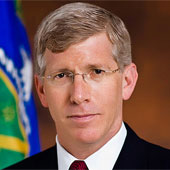The History of the World is the History of Energy
What kind of investments should government undertake to produce a more secure and cleaner energy future?
December 17, 2012

The history of the world is really the history of energy. We have seen human conflict and human progress intertwined with energy dating back to the discovery of fire.
This is something that President Obama has understood very clearly from the beginning of his administration. He has been very clear in defining an energy strategy that comprehends every aspect of our future.
It is an “all of the above” strategy. It is a strategy in which the hydrocarbon wealth of the world has undergone remarkable transformations in recent years.
We have witnessed, from very modest beginnings, an absolute revolution in natural gas markets. In 1978, most people were not really thinking about natural gas as a long-term energy solution to our nation’s problems.
And at that time, the U.S. Department of Energy invested very modestly — $137 million over the course of about 14 years, from 1978 to 1992 — in two technologies that the private sector showed very little interest in then: horizontal drilling and hydraulic fracturing.
But from that modest beginning, we have seen the transformation that we have now experienced to tremendous benefit. Since 2002, U.S. natural gas has increased from 2% to over 35% out of a 22-trillion cubic foot annual natural gas economy. That is the benefit we have derived from natural gas out of shale deposits.
The United States is now the leading producer of natural gas in the world. It is producing tens of thousands of jobs. It is bringing manufacturing back to the United States in areas such as the petrochemical industry.
Yet this is a benefit that is not confined to the United States. We are finding tremendous natural gas resources all around the world.
The U.S. Energy Information Administration took a global survey and found very significant resources of natural gas in many other countries. There is over 800 trillion cubic feet in China, approximately 485 trillion cubic feet in South Africa, over 700 trillion cubic feet in Argentina, and many places besides, including in Central Europe.
This is something that promises great progress not only in terms of reducing climate change impacts because of the much lower greenhouse gas emissions that come from natural gas compared to coal. It also promises the great prospects of fuel switching and the transformation of our nation’s transportation fleet.
Equally impressive is a story that is just now being told: the story of oil in the United States. In just a few short years, we have seen a remarkable transformation there as well.
In 2008, the United States imported about 57% of its domestic oil needs. Now it is down to 42%, in part because U.S. oil production has increased to levels not seen since 1995. And, incredibly, the United States has become a net exporter of oil products for the first time since 1949.
The president has been very clear in his commitment to the continued responsible development of U.S. oil and gas resources, and we will continue to proceed down that path.
With regard to coal, as a nation, we see the importance of investing in clean coal technology and have done so during the Obama Administration. We have invested in carbon capture and sequestration. We have explored the possibilities to use re-injection of carbon into our oil fields to further enhance our recovery.
But the president has been equally clear that the fact of the windfall of a tremendous increase in our hydrocarbon production, which draws from these improvements in our technology, does not excuse us from both the opportunity and, frankly, the obligation, to transform our nation’s energy economy.
We need to continue to make the investments in clean energy technologies and improved battery performance and better wind turbine technology that are going to help create a lower carbon future for the United States.
Assisted by the U.S. Congress through the American Reinvestment and Recovery Act, we made about $30 billion of direct investments leveraging on the order of $90 billion of total investment in clean energy projects and technology. As a direct result, we are seeing some of the largest wind farms and solar farms in the world being built in the United States.
When you get the scale of these investments up high enough, the marginal cost of the capital that is required to invest in them goes down. And as you do that, then more and more renewable energies become more competitive than they otherwise would have been.
That is the direction that we want to see the economy go in eventually, so that we are able, by reducing the cost of capital for some of these renewable technologies, to bring the costs down to the point where they are actually competitive at a levelized cost of electricity standard against some of the conventional forms of energy.
Once that happens, then renewable forms of energy can compete very effectively against conventional forms of energy. And then, we will get the benefits of economical energy to drive our economies as well as the benefits of reduced climate emissions that President Obama has made clear we are going to continue to focus on.
When it comes to renewables and clean sources of energy, there are a lot of things that drive the United States in that direction out of sheer considerations of competitiveness. For example, the propagation of new energy standards for appliance efficiency around the world.
All of these standards drive innovation to reduce the consumption of energy. That is not done for sentimental reasons in the least, but to reduce the cost of energy requirements that economies around the world will continue to have, and therefore will spur economic growth.
Whether it is through clean energy standards or new appliance efficiency standards, we are going to continue to find ways in which, in a sheer economically driven analysis, profitable investments can be made.
And in terms of our “all of the above” strategy, let us also not forget the role that nuclear energy has to play. The United States already draws one-fifth of its power from nuclear energy. And that’s 70% of our carbon-free power.
We have learned a lot and have studied deeply the lessons from the Fukushima disaster in Japan. But we still have over a dozen countries around the world building over 60 nuclear power plants.
They understand that when it comes to transforming our nations’ energy economy in a manner that minimizes the introduction of carbon into the atmosphere, nuclear power still remains a very important part of our energy future.
A global challenge and a global problem
Energy is a global challenge and a global problem. The United States has worked with China, with India, with Kazakhstan, with countries in the Middle East, Asia, South America — Argentina and Brazil — throughout Europe in Poland, France and the United Kingdom.
We have introduced cooperation in development of smart grids. All of us face the challenges of introducing new mechanisms to bring intermittent sources of energy such as solar and wind to an increasingly informed consumer public through smart metering.
Our cooperation has to extend not only to the introduction of modernized grid sensors and phasers, but also to the protection of that grid against natural disasters, such as we have witnessed in the United States very recently with Hurricane Sandy.
We also need to be concerned about those who wish us ill, using the power of technology to interfere with the prosperity of our nations that we are able to manifest through our modernized electrical grid.
We are also looking forward to the opportunities that are presented by advancing technology in the electrification of the nation’s vehicle fleet. The exciting prospects that the global revolution in shale gas and other unconventional sources of gas have brought us present opportunities not only for stationary sources of power generation, they are also relevant in terms of improving our options in terms of transportation.
Let me give a concrete example. In going out to Arkansas and visiting the Fayetteville Gas Shale, I went to a compressed natural gas station where I could fill up my car with compressed natural gas at a price of $1.10 per gas gallon equivalent, at a time when my local filling station was charging $4 a gallon.
That kind of price deferential can drive innovation. A few years ago, the Department of Energy set up ARPA-E, the Advanced Research Project Agency for Energy. It was modeled on the Defense Advance Research Project Agency (DARPA).
We invested in 30 projects to look at ways in which you could shrink the size and weight of the tanks for compressed natural gas vehicles. If we could pack more molecules in and get a more efficient pump to fill up the CNG vehicles, we could take a now-huge gas resource and find a way to scale it up from just 2% of the vehicle fleet to something that could propagate across the entire light-duty vehicle fleet.
If we do that, we could end up having 60% of the market comprised of natural gas vehicles. All of these prodigious resources of gas that we are finding would reduce climate emissions and find a cheaper way for people to drive around.
Energy can be the glue that brings many nations together, but if we are not careful, it can be the accelerant that breaks us apart.
We must continue to be wise and responsible stewards of these resources. We have to recognize that, with the opportunity that it presents all of us for global growth, come responsibilities to assure that we manage the resource responsibly and well and wisely.
We must use it as a force that will help bring the prosperity and security that we all seek and avoid many of the dangers that are all very real. If we achieve that, then all of us could face a very bright and prosperous future.
Editor’s note: This essay was adapted from the author’s remarks at the Atlantic Council’s Energy & Economic Summit 2012 in Istanbul, Turkey, on November 15, 2012.
Takeaways
Energy can be the glue that brings many nations together, but if we are not careful, it can be the accelerant that breaks us apart.
President Obama has been clear that the increase in our hydrocarbon production does not excuse us from the obligation to transform our energy economy.
We need to continue to make the investments in clean energy technologies to help create a lower carbon future for the United States.
We want renewable forms of energy to compete very effectively against conventional forms of energy.
The United States already draws one-fifth of its power from nuclear energy. And that's 70% of our carbon-free power.
Read previous

Turkey and the Politics of Water
December 15, 2012
